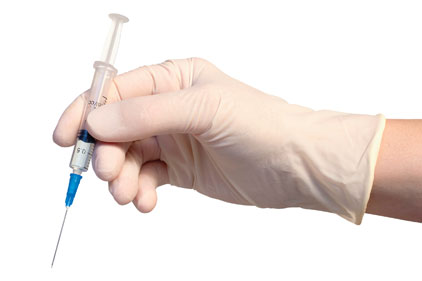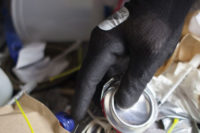A puncture wound as small as 0.00725" can be deadly — when it’s made by the tip of a hypodermic needle containing dangerous microorganisms. Known as bloodborne pathogens, these microorganisms can carry life-altering diseases like HIV and hepatitis A, B and C into the bloodstream.
About 385,000 injuries involving hypodermic needles and other sharp objects occur annually among hospital employees in the U.S., according to the Centers for Disease Control and Prevention (CDC).
Nursing staff are the most frequently injured. OSHA estimates 5.6 million workers in the healthcare industry are at risk for sharps injuries.1
The type of device involved in a sharps injury makes a big difference in the level of risk. In hospital settings, most sharps injuries come from suture needles. Only 13 percent are caused by hollow-bore needles, but these are much more likely to transmit infection, because the volume of blood transferred through a hollow-bore needle is double that of a suture needle.
Workers at risk
Health care professionals are not the only workers exposed to this hazard. People who work in law enforcement, customs, park maintenance, the funeral industry, garbage collection and the body piercing/body art industry are also in danger.
Plus, needles aren’t the only concern. Scalpels, blood collection and phlebotomy devices, broken glass and other sharp objects which may be contaminated can all inflict serious injury.
Puncture protection and dexterity
Prevention has traditionally focused on the use of safer devices and better work practices. Today, puncture-resistant gloves are being explored as a means of protection. Double gloving — the practice of wearing one glove over another — has been shown to reduce a blood-exposure risk by as much as 87 percent when it’s used in operating rooms.2
But many health care professionals are reluctant to double glove. It affects tactile sensitivity and the dexterity needed to perform complex surgical procedures. Help may be on the way. Researchers at the Institut de recherche Robert-Sauvé en santé et en sécurité du travail (IRSST) in Québec reported in 2012 developing a method for testing glove material specifically for needlestick puncture resistance3 — a method that has been adopted in the current versions of the ASTM and ISO standards for measuring the cut resistance of protective clothing (ASTM F1790-05
and ISO 13997). This was the only study of testing gloves for needlestick puncture resistance ISHN was able to reference.
The IRSST scientists took into account the influence of needle characteristics, test material properties and experimental conditions like angle, temperature and humidity. One major improvement they made in puncture testing: the use of probes of a size and shape that more closely match the hazards in question, rather than using sharp objects found in industrial settings. They also simulated the real workplace conditions in which gloves are used, which yielded some important results:
Applying a lubricant can significantly reduce the needlestick resistance of materials
Much less force is needed to puncture gloves that are deformed from wear
A (simulated) hand in a glove had little effect because a needlestick is “very local in nature and does not involve significant deformation of the protective material.”3
The new method was used to test protective gloves for three types of mechanical hazards: needlesticks, puncture and cutting, so that the findings can help people choose gloves that offer protection against the specific hazards they may encounter.
“It is important to realize, however, that choosing gloves demands a compromise between protection and usability/comfort,” caution the researchers, who note that glove selection must be based on a risk analysis that identifies and quantifies all of the hazards involved.3 Additionally, factors such as comfort, flexibity, grip, dexterity and tactile sensitivity affect the users’ ability to perform their tasks and willingness to wear the gloves.
Another important consideration: The long-term impact of wearing gloves, and the possibility that certain types of materials might lead to increased fatigue and musculoskeletal problems. With this in mind, the researchers say: “Emphasis should be placed on choosing the right level of protection, rather than trying to overprotect.”3
Using their new testing method, the IRSST team found four types of materials offer the best needle-related puncture resistance: fabric consisting of tiny hard plates attached to a textile backing; those containing a fine weave of aramid fibres; a model containing many layers of a fine nylon fabric; and another model having fine metal mesh between the liner and the outer shell.
References:
1. www.osha.gov/SLTC/etools/hospital/hazards/sharps/sharps.html
2. C. Berguer, R., & Heller, P. J. (2004). Preventing sharps injuries in the operating room. Journal of the American College of Surgeons, 199(3), 462-467.




